Buying a used shotgun
by Thomas Tabor
Quality firearms are expensive and each year the prices seem to go even higher. As the prices continue to soar, more shooters are considering purchasing used, rather than new firearms. Not only are used firearms often cheaper to buy, many shooters feel the older versions are better quality overall. Aside from these issues, it can be great fun simply looking for used gun bargains. In my own case, some of the best guns I have ever owned were purchased second-hand, maybe even third or fourth hand.
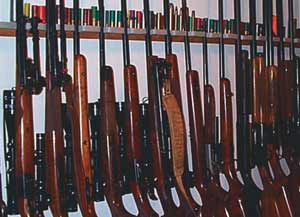
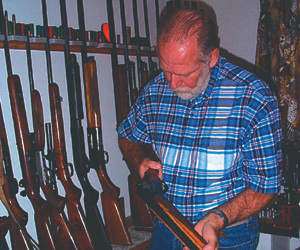
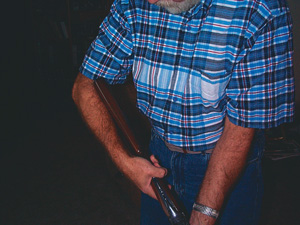
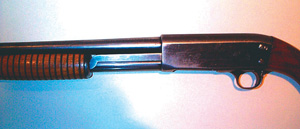
Your first impression of a used gun is an important one. Ask yourself
if it appears the gun has been looked after. Are there obvious signs of
abuse - such as rust, scratching, pitting, dents, or wear marks that
could be costly to repair? Has the owner made any modifications to the
stock or metalwork? If you answer ‘yes’ to any of these questions, it
doesn’t necessarily mean the purchase won’t be a good one. These
questions should be part of your overall evaluation. The price you pay
must take into account any expenses you might incur for repairs.
Light surface rust on the outside of the barrel, action and other outer surfaces is sometimes common on used guns. In many cases minor rust spots can easily be scrubbed away with a piece of fine steel wool and a little solvent. On the contrary, if heavy rust and deep pitting is present, particularly inside the bore, it is wise - in most cases - to walk away from the sale. Such damage can certainly hinder the gun’s accuracy and functionality, but even more importantly - it can raise concerns of shooting safety. Any pitting inside the bore will most likely mean the barrel needs replacing and new barrels are expensive. Some current manufactured shotguns and even a few rifles are built in a way that the barrels are interchangeable. While this eliminates the cost associated with a gunsmith fitting the barrel to the action, replacing a barrel can still cost a lot of money. Another way of looking at it is: if the barrel is that bad, most likely you can figure the whole firearm has been abused.
The replacement of barrels on double-barrelled firearms can be extremely expensive. In some cases the barrels can be ‘mono-blocked’ for less money. The term mono-blocked means that the barrels are cut off just ahead of the chamber and new tubes are inserted. While this type of work is certainly much less expensive than replacing the entire barrel-set, it can still easily run into the hundreds of dollars. Another problem somewhat common in the case of doubles, is separation of the barrels and ribs. Resoldering these is also an expensive and timely project requiring the services of a professional gunsmith.
Before we go any further with what to look for in used guns, let’s look at collector value and appropriate repairs for collectable pieces. While most of us want our firearms to look new and unmarred, sometimes it is better a firearm is not altered, even if the work may improve its outward appearance. The value of collectable firearms can be severely reduced if, for example, the stock has been refinished, replaced or altered. The same applies if the gun has been reblued, or if it has experienced any other irreversible alterations. Collectors want firearms that are completely unaltered. What might appear to be minor cosmetic modifications can easily reduce the overall value by 50 per cent or more. Replacement of parts is sometimes looked on favourably in these situations, but at a minimum, any repair part must be identical to the original.
On the other hand, if your interest lies only in a serviceable rifle or shotgun for hunting and target shooting, modifications to improve appearance or increase performance can actually add value to the piece. In this case, as long as the work was accomplished in a professional manner it is usually deemed acceptable.
It is important not to confuse blueing wear with abuse. Blueing wear by itself is not a valid indicator of the firearm’s overall condition. In my own collection, I have several pieces that have essentially none of the original blueing left, yet, in every other aspect they are in superb condition. Such a cosmetic condition can simply be the result of carrying the firearm in a gun-rack of a vehicle, or in a scabbard on horseback.
Satisfactory touch-up to blueing jobs can sometimes be accomplished with a bottle of instant blue. This works well to cover up small spots of wear. It doesn’t provide the quality and durability of a professional hot-blueing process, or rust-blueing, but for small cosmetic work it’s a great substitute.
Dents and heavy scratches in the stock can sometimes be removed by refinishing if they are not excessive. Stock refinishing is labour intensive, but most people with a little woodworking ability can turn out an acceptable job. A very big mistake that many first-time gunstock refinishers make is to apply the stock finish to the chequering. When this happens the chequering becomes clogged with finish, rendering it worthless and to be perfectly honest about it - it makes a nice chequering job really ugly. You should avoid sanding the chequered areas and protect them from damage while the stock is being worked on. This can be done by carefully masking the chequered areas with several layers of masking tape. After the stock has been refinished you can apply a minuscule amount of thinned-down gunstock or linseed oil to these areas if you think it is necessary.
Many used firearms have had their recoil pad or buttplate replaced. Many times the replacement job is a sloppy one and you may have to redo it. If the recoil pad, or plate, has been changed it could mean the original length of the stock has also changed. The stock may have been shortened. Or, the hard buttplate may have been replaced with a thick, rubber recoil pad, making the overall length longer. In this case a stock-maker can certainly cut a stock off to make it shorter. If, however, the stock has been cut off for a shooter of small stature, bringing it back to proper length could be a real problem. In some cases, spacers can be added between the stock and the recoil pad to lengthen the pull. The pad could possibly be replaced with a slightly thicker one, but if an excessive amount of wood has been removed it may be necessary to replace the stock.
A rudimentary way to see if a stock fits you is to place the stock against your forearm. With your finger on the trigger, does the butt fit nicely against the inside of the elbow-joint of your arm? The trigger should be positioned against the crease of the first finger joint. If you have to reach to get to the trigger - the stock may be too long. If the butt of the gun doesn’t contact the inside of your elbow-joint - the stock may be too short.
Barrels are a critical area that should be closely scrutinised. Unfortunately, excessive wear is not always readily visible. Some of the ultra-high velocity calibres that are popular today can be extremely hard on barrels, even if the owner takes extraordinary care to clean them after each use. Calibres such as the .264 Win. Mag., .22-250, .220 Swift, many of the Weatherby calibres and other fast flyers, experience considerably shorter barrel life than the calibres that travel a few hundred feet-per-second slower and burn a few less grains of powder. That is not to say that these calibres shouldn’t be considered for purchase, but care should be taken to ensure that you are not buying a rifle that needs a new barrel.
Always inquire how many rounds a firearm has had shot through it. An average hunter would most likely never shoot a barrel out in his or her lifetime, but an active varmint hunter shooting his favourite .22-250, or a target shooter, may destroy several barrels during a few short years.
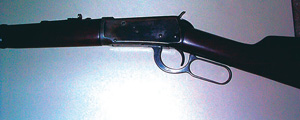
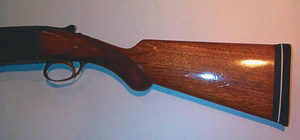
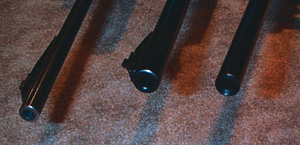
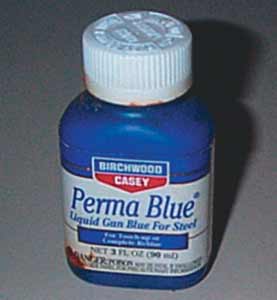 Shotgun stocks, particularly those on trap guns, have sometimes
undergone some modifications that may not be to your benefit. Some of
the most severe changes found in shotguns are to the height of the comb
(the area of the stock where your cheek rests). A very small amount of
wood removed from this area can dramatically change the gun’s point of
impact and be very hard to correct.
Shotgun stocks, particularly those on trap guns, have sometimes
undergone some modifications that may not be to your benefit. Some of
the most severe changes found in shotguns are to the height of the comb
(the area of the stock where your cheek rests). A very small amount of
wood removed from this area can dramatically change the gun’s point of
impact and be very hard to correct.
If you are inspecting a firearm for a potential purchase, work the action slowly several times, looking for signs of excessive wear, or lack of smoothness. With heavy recoiling firearms you should look for cracks in the stock. Inspect carefully behind the action, where the wood meets the metal, and near the top of the grip or tang. A stock-maker can sometimes stop a small crack from progressively getting worse with epoxy and a plug, but a bad crack is difficult to correct.
Prospective rifle buyers should always carefully inspect the barrel’s crown (muzzle end of the barrel) looking for any nicks or dings. Any irregularities in this area can result in accuracy problems. Most gunsmiths can correct this situation by re-crowning the barrel. This work isn’t necessarily inexpensive, but the cost won’t break the bank either.
Shotgun barrels should be inspected for dents or bulges. In either case these can produce a safety hazard for the shooter. A gunsmith can sometimes remove a dent from a barrel, though bulges are almost impossible to eradicate, short of barrel replacement.
There are many military rifles on the market today being marketed for sporting use. Generally speaking, a military rifle - whether modified for sporting use or not - is usually not the best choice for most shooters. A proper sporterising job would include replacing virtually everything except possibly the action and the bolt and sometimes even those parts need some modifications made to them. You may as well buy a new rifle.
It is always a good idea to test fire a used gun prior to purchasing it. If live fire testing is possible you should pay particular attention to how easily the cartridges feed and eject. Take a look at the spent brass. Does it show signs of excessive headspace? Are there rub marks on the brass that may indicate the gun has feeding problems? At this point don’t worry too much about shooting accuracy, but don’t ignore it either. If a gun doesn’t group well, sometimes something as simple as a thorough cleaning might improve its ability to group the shots, or possibly a change of cartridge brand may help. Note the recoil; will it be too much for you to handle?
Damascus barrels should be avoided unless you are looking for a collector’s item. Damascus barrels were produced well into the 1900s. Damascus steel was made by twisting and welding small pieces of rod together to form larger ones. These bars were then coiled around a mandrel and forge-welded in a spiral to form the barrel. These were beautiful barrels, but they were designed for use with black powder, not the modern smokeless powders of today. Damascus steel simply can’t be relied upon to be safe at the pressure levels generated by today’s powders. To identify barrels made of Damascus steel, look for the fine squiggly patterns in the metal.
I sincerely hope I haven’t frightened anyone away from purchasing a used firearm. Shopping for and buying used guns can be great fun if you approach the purchase properly. There are still a few bargains out there just waiting for you. That’s if I don’t find them first.
Good shootin’ and good shoppin’.
Captions
Image 1: There are a lot of used guns out there
and it can be great fun finding a bargain.
Image 2: Before purchasing a used firearm, it is
always a good idea to check the gun thoroughly. In the case of a
break-open firearm, like this over and under, it is important to make
sure it locks up tight when the action is closed.
Image 3: By placing the shotgun butt stock
against your forearm in this manner it will tell you roughly if the
stock is the right length for you. A proper fitting stock should rest
against the inside of your elbow-joint when your finger is on the
trigger.
Image 4: The blueing on the author’s Ithaca is
mostly worn off. It was bought used and showed a lot of signs of
carrying, but other wear was nil.
Image 5: The author’s Winchester 1894 saddle gun
had apparently been carried a lot on horseback. The wear to the blueing
would seem to indicate that, but otherwise the rifle was in excellent
condition.
Image 6: The stock on the author’s Browning
Superposed over and under needed to be slightly lengthened. A black
plastic spacer was added between the recoil pad and the butt.
Image 7: The rifle on top has almost all of the
blueing burned off as a result of a lot of firings. A rifle muzzle
appearing like this could have seen a lot of actual use, while the
other two rifles seem to show very little sign of actual firings.
Image 8: A bottle of ‘instant’ or ‘cold blue’
(Perma Blue by Birchwood Casey) is a great addition to any shooter’s
arsenal of gun supplies and equipment. While it doesn’t do as good a
job as a hot blue or rust blue process, it is great for small jobs.
